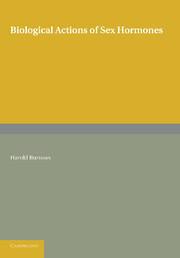Book contents
- Frontmatter
- CONTENTS
- PREFACE
- PART I GONADOTROPHINS
- CHAPTER I The Nature and Functions of Gonadotrophins
- CHAPTER II Factors which Influence the Gonadotrophic Activity of the Pituitary
- CHAPTER III Factors which influence the Reaction of the Gonads to Gonadotrophins
- CHAPTER IV Factors which affect the Cytological Structure and Weight of the Anterior Lobe of the Pituitary
- PART II GONADAL HORMONES
- PART III ANDROGENS
- PART IV OESTROGENS
- PART V PROGESTINS
- PART VI SEX HORMONES OF THE ADRENAL CORTEX
- APPENDIX
- REFERENCES
- GLOSSARY
- INDEX
CHAPTER IV - Factors which affect the Cytological Structure and Weight of the Anterior Lobe of the Pituitary
from PART I - GONADOTROPHINS
Published online by Cambridge University Press: 05 June 2016
- Frontmatter
- CONTENTS
- PREFACE
- PART I GONADOTROPHINS
- CHAPTER I The Nature and Functions of Gonadotrophins
- CHAPTER II Factors which Influence the Gonadotrophic Activity of the Pituitary
- CHAPTER III Factors which influence the Reaction of the Gonads to Gonadotrophins
- CHAPTER IV Factors which affect the Cytological Structure and Weight of the Anterior Lobe of the Pituitary
- PART II GONADAL HORMONES
- PART III ANDROGENS
- PART IV OESTROGENS
- PART V PROGESTINS
- PART VI SEX HORMONES OF THE ADRENAL CORTEX
- APPENDIX
- REFERENCES
- GLOSSARY
- INDEX
Summary
Seasonal changes. The oestrous cycle. Pregnancy, pseudopregnancy and lactation. Gonadal hormones. Gonadotrophin. Sex. Castration, and destruction of seminal epithelium. Nutrition. Age.
SINCE Fichera (1905 a) called attention to the fact that castration is followed by enlargement of the anterior lobe of the pituitary gland with histological changes in its structure, many workers have confirmed and amplified his original observations ; and the cytology of the pituitary has become a subject of much importance in endocrinological studies of various kinds. The matter will be discussed briefly here in order to correlate, if possible, the changing cellular constitution of the pituitary with its gonadotrophic functions and with the activities of the reproductive organs.
Normally the glandular cells of the anterior lobe of the pituitary are of three main types, namely chromophobe, eosinophile and basophile, the chromophobe being regarded as the parent of the other two. The relative numbers of these cells vary in different physiological conditions. Besides this changing numerical relationship the cells undergo alterations in volume and other features during different stages of sexual activity. In pregnant or castrated animals, cells with special and distinctive characters occur and are known as ‘ pregnancy cells’ and ‘castration cells’ respectively. In the embryo chromophobes only are seen (Tuchmann, 1937).
Seasonal Changes
In animals with limited breeding seasons, during periods of sexual quiet when the output of gonadotrophin is at a minimum, small chromophobe cells predominate in the pituitary; a resumption of the sexual function is associated with an increase in the number and dimensions of the chromophiles. Cushing & Goetsch (1913, 1915) observed that sexual inactivity, whether associated with clinical evidence of hypopituitarism in man, or with experimentally produced pituitary deficiency in animals, or during hibernation, is accompanied by a reduction in the number and size of the chromophilic cells in the pars anterior. They confirmed the work of Gemelli (1906), who studied the seasonal changes in the pituitary of the marmot and showed that in this animal at the end of hibernation the pituitary swells, the glandular cells enlarge and the chromophiles stain more deeply.
- Type
- Chapter
- Information
- Biological Actions of Sex Hormones , pp. 85 - 95Publisher: Cambridge University PressPrint publication year: 2013

